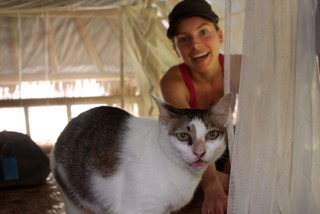Yoga Teacher Volunteer at Jiwa Damai
/Our lovely yoga teacher volunteer, Bee at Jiwa Damai is sharing some of her thoughts with you regarding her experience here. She has been our “busy bee” for the last couple of months helping us start the day with yoga in the morning and teaching our local team English. Originally from Austria, Bee has been traveling in order to find her path as a yoga instructor. We are very grateful for all the positive energy she has brought to this place.
You can find out more about our volunteer program here or just follow the stories from our volunteers on the Jiwa Damai blog. In the meantime, we invite you to discover the way Bee has experienced her stay at Jiwa Damai.
What made you chose Jiwa Damai? I was searching for a place to practice yoga and to teach, for a healthy environment. I believe that yoga is a lifestyle and in order to follow it, you have to select carefully your surroundings. At the same time, it is hard to find a place where you can start with teaching when you don’t have prior experience. I was reading that Jiwa Damai is looking for volunteers and that they offer yoga in the morning so I thought that I could start to teach and also learn more about yoga here. The beautiful part is that they offered me this chance! I’ve been at Jiwa Damai for almost two months now. And I am happy to say that I had my first yoga students here.
What are the things that you appreciated most in your experience at Jiwa Damai? At Jiwa Damai I liked the fact that I could get new experiences. Not only as a yoga instructor. Margret asked me if I can teach also English. When you are not very confident with speaking a language, you would not expect such an invitation. My English is not perfect but by preparing the lessons, I had the chance to improve it and share my knowledge with others. I could develop new skills in an area where I could not imagine that I would be able to do so.
I also appreciated the fact that I could eat food from the garden. At the same time, I worked in the garden and saw how the things are growing. I’ve cleaned the elephants and the stones. One does many things. But this is how one gets a feeling for plants, for the environment, for the nature. I think there is a lot to learn at Jiwa Damai and two months is not enough.
It is nice to see how the plants grow, how people grow, not only the volunteers but also the local team. Even after the first three weeks, you can see a difference.
What should a yoga teacher volunteer expect coming here? I think a yoga teacher volunteer should just be opened. If you want to learn something, there are so many things you can learn. It can be gardening, teaching, interacting with people with different cultural backgrounds. I believe everyone experiences Jiwa Damai in their own way.
On the one hand, you live here, you find new friends, you feel at home (when you are traveling you really need this), and on the other hand you are traveling in your days off and you can discover Bali and its rich culture.
What do you think it is unique about the volunteer program at Jiwa Damai?
What I really like actually is that people get here their own projects and Margret lets them discover it by their own. People get here projects according to their interests and skills. Cat did a wonderful research on the coconut beetles, Cedric is researching on cacao. I was developing teaching skills. So if you are curious, Margret gives you the space and the support to explore and create something nice on your own.
Bee (yoga teacher volunteer)




















